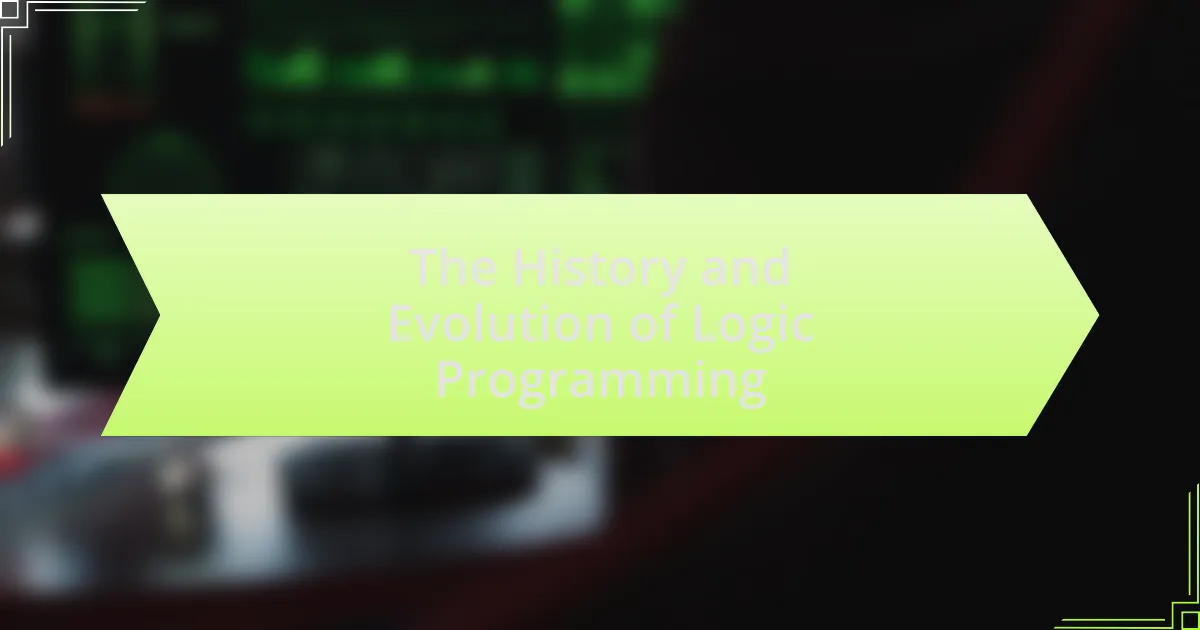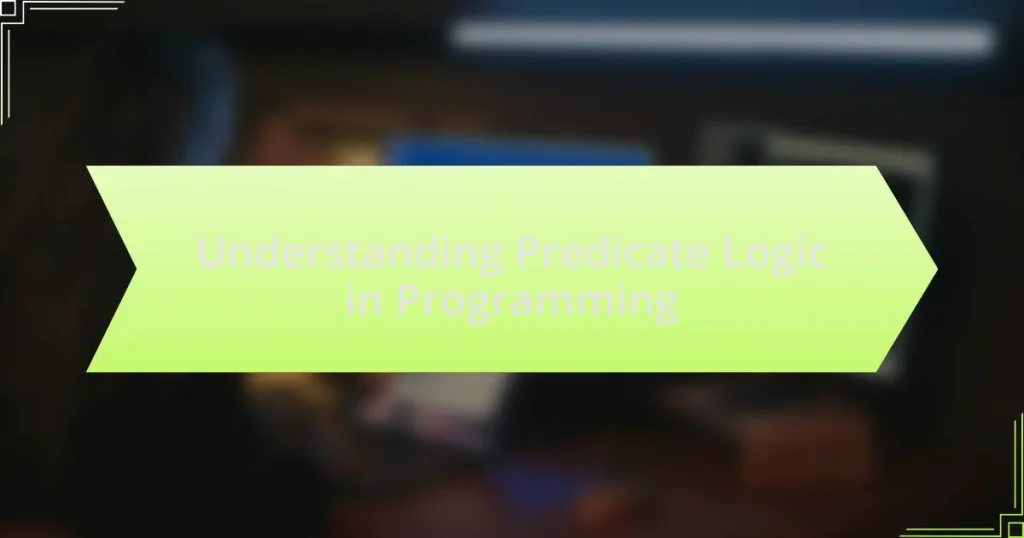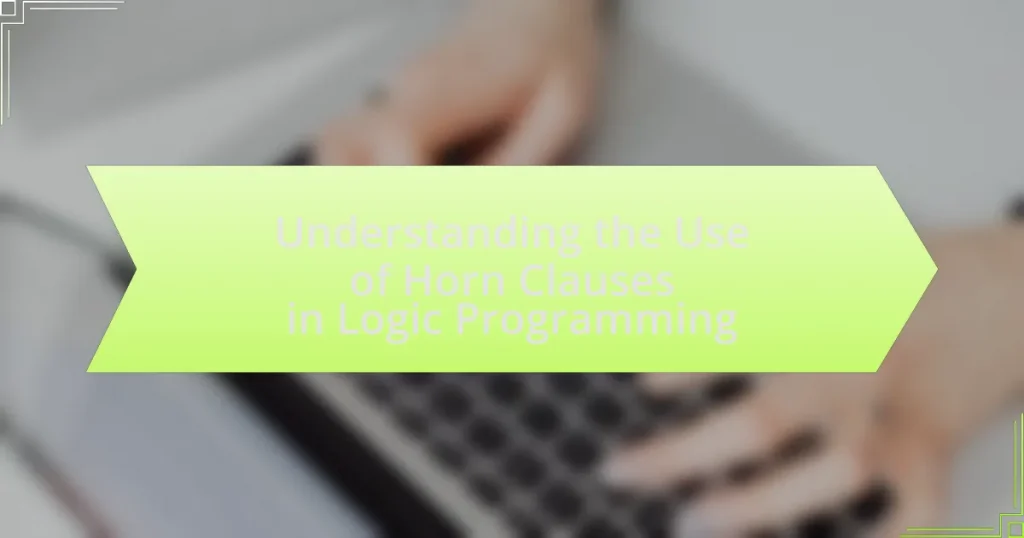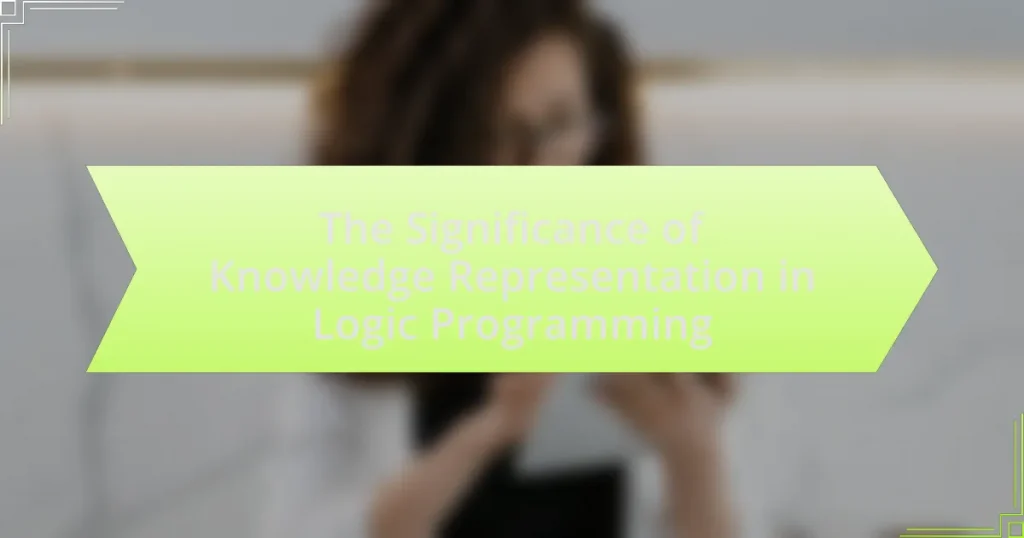The article focuses on the history and evolution of logic programming, tracing its origins to the 1960s with the development of Prolog by Alain Colmerauer and his team. It highlights key developments in the field, including the establishment of foundational concepts such as facts, rules, and queries, as well as significant milestones like the introduction of constraint logic programming and the Warren Abstract Machine. The article also discusses the contributions of pioneers like Robert Kowalski, the differences between logic programming and other paradigms, and the challenges faced throughout its history. Furthermore, it examines the current state of logic programming, its applications in various fields, and emerging trends that shape its future direction.
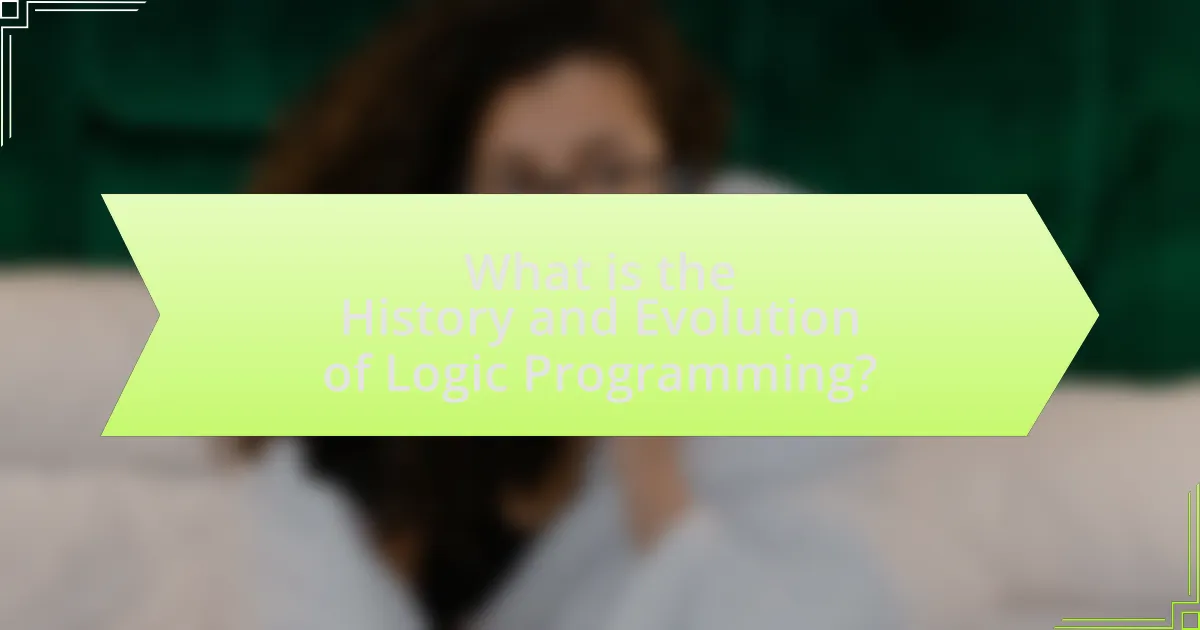
What is the History and Evolution of Logic Programming?
Logic programming originated in the 1960s with the development of Prolog, a programming language designed for symbolic reasoning and problem-solving. Prolog was created by Alain Colmerauer and his team in France, building on earlier work in formal logic and artificial intelligence. The evolution of logic programming continued through the 1970s and 1980s, as researchers expanded its applications in areas such as natural language processing, theorem proving, and expert systems. Notably, the introduction of constraint logic programming in the late 1980s further enhanced the capabilities of logic programming by allowing for the specification of constraints in addition to logical rules. The field has since diversified, incorporating concepts from functional programming and object-oriented programming, leading to modern implementations that support various paradigms while maintaining the core principles of logical inference and declarative programming.
How did logic programming originate?
Logic programming originated in the late 1960s with the development of the programming language Prolog, which was designed by Alain Colmerauer and his team in France. Prolog was based on formal logic, specifically first-order predicate logic, allowing for a declarative programming style where the programmer specifies what the program should accomplish rather than how to achieve it. The language’s foundation in logic enabled automated reasoning and problem-solving capabilities, which were further enhanced by the introduction of backtracking algorithms. This approach to programming marked a significant shift from imperative programming paradigms, establishing logic programming as a distinct field within computer science.
What were the key developments in the early days of logic programming?
The key developments in the early days of logic programming include the introduction of Prolog in the early 1970s, which was designed for artificial intelligence applications, and the establishment of the resolution principle by John Alan Robinson in 1965, which provided a foundation for automated theorem proving. Prolog’s creation by Alain Colmerauer and his team at the University of Marseille marked a significant shift in programming paradigms, emphasizing declarative programming over imperative programming. The resolution principle enabled logical inference and automated reasoning, which became central to logic programming. These developments laid the groundwork for subsequent advancements in the field, influencing both academic research and practical applications in AI and beyond.
Who were the pioneers in the field of logic programming?
The pioneers in the field of logic programming include Robert Kowalski, who developed the foundational concepts of logic programming in the early 1970s, and Alain Colmerauer, who created Prolog, the first widely used logic programming language. Kowalski’s work on the procedural interpretation of logic and Colmerauer’s implementation of logic programming in Prolog established the framework for the discipline. Their contributions laid the groundwork for subsequent developments in artificial intelligence and computational logic.
What are the foundational concepts of logic programming?
The foundational concepts of logic programming include facts, rules, and queries. Facts represent basic assertions about the world, rules define relationships and infer new information from existing facts, and queries allow users to ask questions about the data represented in the program. These concepts are rooted in formal logic, particularly predicate logic, which provides the framework for expressing logical relationships and reasoning. Logic programming languages, such as Prolog, utilize these concepts to enable automated reasoning and problem-solving, demonstrating their effectiveness in fields like artificial intelligence and computational linguistics.
How does logic programming differ from other programming paradigms?
Logic programming differs from other programming paradigms primarily in its use of formal logic as a programming language. In logic programming, programs consist of a set of sentences in logical form, expressing facts and rules about a problem domain, which allows for automated reasoning and inference. This contrasts with imperative programming paradigms, where the focus is on explicitly defining a sequence of commands to manipulate data, and object-oriented programming, which emphasizes encapsulation and the interaction of objects. The foundational logic programming language, Prolog, exemplifies this paradigm by allowing developers to declare relationships and query them, rather than specifying how to compute results step-by-step, as seen in other paradigms.
What are the core principles that define logic programming?
The core principles that define logic programming include the use of formal logic as a programming paradigm, where programs are expressed in terms of relations and rules rather than procedures. Logic programming relies on a declarative approach, allowing the programmer to specify what the program should accomplish without detailing how to achieve it. This paradigm is exemplified by languages such as Prolog, which utilize facts, rules, and queries to derive conclusions through inference. The correctness of logic programming is supported by its foundation in mathematical logic, particularly first-order predicate logic, which provides a rigorous framework for reasoning about the relationships between data.
What significant milestones have shaped the evolution of logic programming?
The evolution of logic programming has been shaped by several significant milestones, including the development of Prolog in the early 1970s, which introduced a practical implementation of logic programming concepts. Prolog was created by Alain Colmerauer and his team, allowing for natural language processing and artificial intelligence applications. Another milestone was the introduction of the Warren Abstract Machine (WAM) in 1983, which optimized Prolog execution and improved performance. The establishment of the logic programming paradigm as a formal framework in the 1980s further solidified its theoretical foundations, with contributions from researchers like Robert Kowalski, who emphasized the importance of resolution and unification. Additionally, the integration of logic programming with other paradigms, such as functional programming and constraint programming, has expanded its applicability in various domains, including databases and knowledge representation. These milestones collectively demonstrate the progression and impact of logic programming in computer science.
What role did Prolog play in the development of logic programming?
Prolog was pivotal in the development of logic programming as it introduced a practical implementation of first-order logic for programming. Developed in the early 1970s by Alain Colmerauer and his team, Prolog enabled programmers to express knowledge in a declarative manner, focusing on what the program should accomplish rather than how to achieve it. This approach allowed for the creation of complex AI applications, such as natural language processing and theorem proving, demonstrating the power of logic-based reasoning in computational tasks. Prolog’s influence is evident in its adoption in various domains, establishing it as a foundational language in the field of artificial intelligence and logic programming.
How have advancements in technology influenced logic programming?
Advancements in technology have significantly influenced logic programming by enhancing computational power and enabling more sophisticated algorithms. The development of faster processors and increased memory capacity has allowed for the execution of complex logic programs that were previously infeasible. For instance, the introduction of parallel processing has improved the efficiency of logic programming languages like Prolog, enabling them to handle larger datasets and more intricate queries. Additionally, advancements in artificial intelligence and machine learning have integrated with logic programming, allowing for more dynamic and adaptive systems. These technological improvements have led to broader applications of logic programming in fields such as natural language processing, automated reasoning, and knowledge representation, demonstrating the profound impact of technology on the evolution of this programming paradigm.
How has logic programming evolved over the decades?
Logic programming has evolved significantly since its inception in the 1970s, transitioning from theoretical foundations to practical applications. Initially, languages like Prolog emerged, emphasizing declarative programming and enabling complex problem-solving through logical inference. Over the decades, advancements included the integration of logic programming with other paradigms, such as functional and object-oriented programming, enhancing expressiveness and usability. The introduction of constraint logic programming in the 1980s expanded its applicability to areas like scheduling and resource allocation. Furthermore, the rise of artificial intelligence and machine learning in the 21st century has led to the development of logic programming systems that support reasoning over uncertain information, exemplified by frameworks like Answer Set Programming. These developments illustrate a continuous trend towards increasing the versatility and efficiency of logic programming in various domains.
What are the major trends in logic programming since its inception?
The major trends in logic programming since its inception include the development of Prolog in the 1970s, the integration of logic programming with functional programming paradigms, and the rise of constraint logic programming in the 1990s. Prolog, created by Alain Colmerauer and Philippe Roussel, established the foundation for logic programming by introducing a declarative approach to problem-solving. The integration with functional programming has led to languages like Mercury, which combines the strengths of both paradigms, enhancing performance and expressiveness. Additionally, the emergence of constraint logic programming has expanded the applicability of logic programming to areas such as artificial intelligence and operations research, allowing for more complex problem-solving capabilities. These trends reflect the evolution and increasing relevance of logic programming in various computational fields.
How have applications of logic programming expanded in various fields?
Applications of logic programming have expanded significantly across various fields, including artificial intelligence, natural language processing, and database management. In artificial intelligence, logic programming facilitates automated reasoning and knowledge representation, exemplified by systems like Prolog, which are used for expert systems and theorem proving. In natural language processing, logic programming aids in parsing and understanding human languages, enabling the development of more sophisticated conversational agents. Additionally, in database management, logic programming underpins query languages such as Datalog, which allows for efficient data retrieval and manipulation. These expansions illustrate the versatility and growing relevance of logic programming in addressing complex problems across diverse domains.
What challenges has logic programming faced throughout its history?
Logic programming has faced several significant challenges throughout its history, including performance issues, scalability limitations, and difficulties in integrating with other programming paradigms. Performance issues arise from the inherent computational overhead of logic-based inference mechanisms, which can lead to slower execution times compared to imperative programming languages. Scalability limitations are evident when logic programs are applied to large datasets or complex problems, as the search space can grow exponentially, making it difficult to find solutions efficiently. Additionally, integrating logic programming with other paradigms, such as object-oriented or functional programming, has proven challenging due to differing underlying principles and execution models. These challenges have hindered the widespread adoption of logic programming in practical applications despite its theoretical strengths.
What limitations have been identified in logic programming approaches?
Logic programming approaches have several identified limitations, including inefficiency in handling large datasets and difficulty in expressing certain types of problems. These limitations arise because logic programming relies heavily on backtracking and unification, which can lead to performance bottlenecks. For instance, in practical applications, the search space can grow exponentially, making it computationally expensive to find solutions. Additionally, logic programming often struggles with side effects and state changes, which are challenging to represent within its declarative paradigm. These constraints hinder its applicability in dynamic environments where mutable states are common.
How have researchers addressed these challenges over time?
Researchers have addressed challenges in logic programming over time by developing advanced algorithms and enhancing computational efficiency. For instance, the introduction of constraint logic programming in the 1990s allowed for more expressive problem-solving capabilities, enabling researchers to tackle complex problems in areas such as artificial intelligence and operations research. Additionally, the evolution of Prolog and its various implementations, such as SWI-Prolog and GNU Prolog, has improved performance and usability, allowing for broader application in real-world scenarios. These advancements demonstrate a continuous effort to refine logic programming methodologies, making them more robust and applicable across diverse fields.
What is the current state of logic programming?
The current state of logic programming is characterized by its integration into various domains such as artificial intelligence, natural language processing, and knowledge representation. Modern logic programming languages, like Prolog, continue to evolve, incorporating features that enhance their usability and performance, such as constraint logic programming and integration with functional programming paradigms. The relevance of logic programming is evidenced by its application in solving complex problems in areas like automated reasoning and expert systems, demonstrating its enduring significance in computer science.
How is logic programming being utilized in modern applications?
Logic programming is utilized in modern applications primarily through artificial intelligence, natural language processing, and knowledge representation. In AI, languages like Prolog enable the development of expert systems that can reason and make decisions based on a set of rules and facts. For instance, Prolog is widely used in applications such as automated theorem proving and constraint satisfaction problems, demonstrating its effectiveness in solving complex logical queries. Additionally, logic programming facilitates natural language understanding by allowing systems to parse and interpret human language based on logical structures. This is evident in applications like chatbots and virtual assistants, which rely on logic-based frameworks to understand user intent and provide accurate responses. Furthermore, logic programming supports knowledge representation in databases and semantic web technologies, enabling efficient querying and reasoning over large datasets.
What are the emerging trends in logic programming today?
Emerging trends in logic programming today include the integration of logic programming with machine learning and the development of constraint logic programming. The combination of these fields allows for enhanced problem-solving capabilities, enabling systems to learn from data while applying logical reasoning. Additionally, there is a growing focus on the use of logic programming in natural language processing, which facilitates better understanding and generation of human language. These trends are supported by advancements in computational power and the increasing availability of large datasets, which enhance the effectiveness of logic-based approaches in various applications.
What future directions can we expect for logic programming?
Future directions for logic programming include enhanced integration with machine learning, increased focus on parallelism and concurrency, and the development of more user-friendly programming environments. The integration with machine learning is driven by the need for systems that can learn from data while maintaining logical reasoning capabilities, as evidenced by the rise of neuro-symbolic AI approaches. Additionally, advancements in hardware are pushing the boundaries of parallel processing, allowing logic programming languages to exploit concurrency more effectively, which is crucial for performance in large-scale applications. Finally, efforts to create more intuitive interfaces and tools aim to broaden accessibility, making logic programming more appealing to a wider audience, as seen in recent educational initiatives and community-driven projects.
How might logic programming evolve in response to new technologies?
Logic programming may evolve through the integration of machine learning and artificial intelligence, enhancing its capabilities for reasoning and problem-solving. As new technologies emerge, such as neural-symbolic integration, logic programming can leverage these advancements to improve its efficiency and applicability in complex domains. For instance, the combination of logic programming with deep learning techniques allows for better handling of uncertainty and incomplete information, which are common in real-world applications. This evolution is supported by ongoing research that demonstrates how hybrid systems can outperform traditional logic programming approaches in tasks like natural language processing and automated reasoning.
What potential innovations could reshape the landscape of logic programming?
Potential innovations that could reshape the landscape of logic programming include the integration of machine learning techniques, enhanced parallel processing capabilities, and the development of more intuitive programming interfaces. Machine learning can improve logic programming by enabling systems to learn from data and adapt their logic rules dynamically, as evidenced by the increasing use of neural-symbolic integration in AI research. Enhanced parallel processing can significantly speed up logic inference tasks, allowing for more complex problem-solving in real-time applications. Additionally, more intuitive programming interfaces, such as visual programming environments, can lower the barrier to entry for new users, fostering broader adoption and innovation in logic programming.
What practical tips can enhance the understanding of logic programming?
To enhance the understanding of logic programming, one practical tip is to engage in hands-on coding exercises using languages like Prolog or Mercury. These languages are specifically designed for logic programming and allow learners to apply theoretical concepts in practical scenarios. Engaging with real-world problems, such as puzzles or database queries, can solidify understanding by demonstrating how logic programming can be used to derive solutions. Additionally, studying existing logic programming projects or participating in online forums can provide insights into best practices and common pitfalls, further reinforcing learning through community interaction and shared experiences.
How can beginners effectively learn logic programming concepts?
Beginners can effectively learn logic programming concepts by engaging with structured resources such as textbooks, online courses, and interactive coding platforms. For instance, foundational texts like “Programming in Prolog” by Clocksin and Mellish provide a comprehensive introduction to logic programming principles. Additionally, platforms like Codecademy and Coursera offer courses specifically designed for beginners, which include practical exercises and community support. Research indicates that hands-on practice, such as solving logic puzzles and implementing small projects, significantly enhances understanding and retention of programming concepts.
What resources are available for further exploration of logic programming?
Books, online courses, and academic journals are key resources for further exploration of logic programming. Notable books include “Programming in Prolog” by Clocksin and Mellish, which provides foundational knowledge and practical examples. Online platforms like Coursera and edX offer courses on logic programming languages such as Prolog and Mercury, enabling learners to engage with interactive content. Additionally, journals like the “Journal of Logic Programming” publish peer-reviewed articles that cover advancements and research in the field, providing insights into contemporary developments and applications. These resources collectively support a comprehensive understanding of logic programming’s history and evolution.
